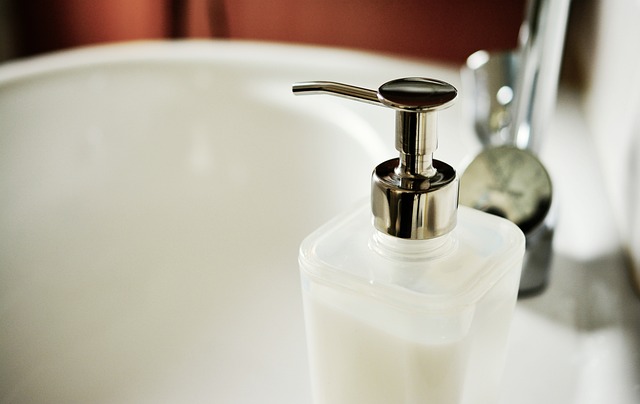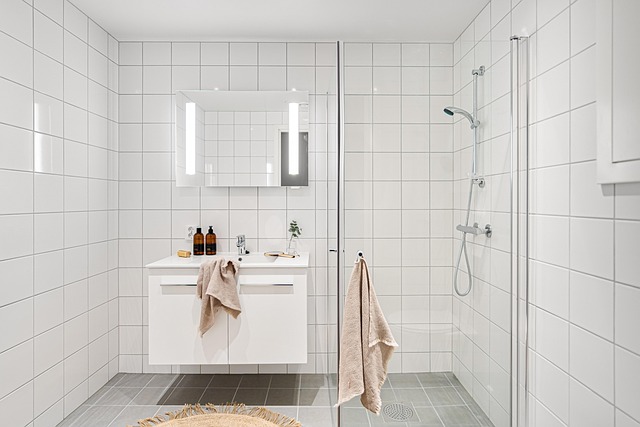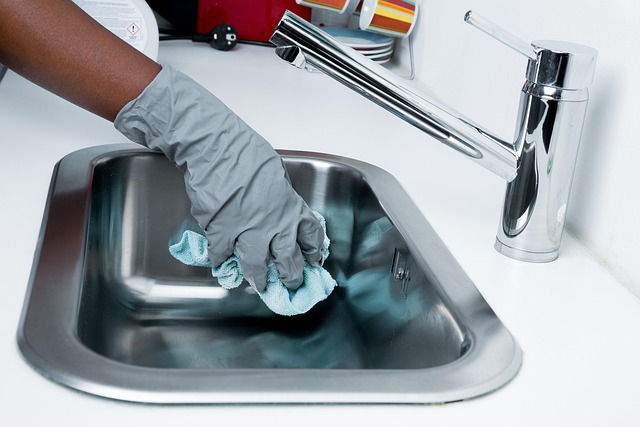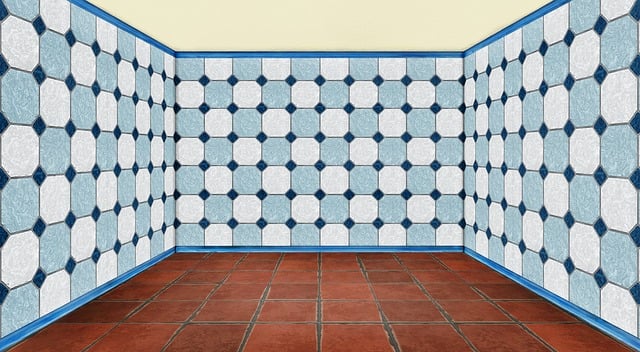Deep tile cleaning in bathrooms and kitchens goes beyond surface scrubbing, targeting crevices and pores to extract embedded dirt, grime, and mold spores. Essential for high-traffic areas, it prevents oil, soap scum, and food particle buildup, restoring tiles' gloss and extending their lifespan. Regular deep cleaning is a game-changer for hygiene, especially in spaces prone to bacterial growth due to moisture and residue. Specialized equipment, pH-neutral cleaners, and tailored approaches based on tile type ensure thorough yet safe cleaning, preserving aesthetics and prolonging durability. Consistent care maintains results, enhancing functionality and visual appeal. Professional services offer superior outcomes by penetrating grout lines and pores, saving time and effort while ensuring tile longevity.
Deep tile cleaning is an essential practice for maintaining the aesthetics and longevity of your flooring, especially in high-traffic areas like bathrooms and kitchens. This article delves into the intricacies of deep tile cleaning, offering a comprehensive guide to understanding the process, its benefits, and specialized techniques for these demanding spaces. Learn about common challenges, the right tools, effective cleaning solutions, and expert tips for long-lasting results, ensuring your tiles stay vibrant and clean. Discover why professional services can make a game-changing difference compared to DIY approaches.
Understanding Deep Tile Cleaning: The Process and Benefits for Flooring

Deep tile cleaning goes beyond surface-level scrubbing. It’s a meticulous process that delves into the crevices and pores of your flooring, extracting embedded dirt, grime, and even mold spores. This method is particularly crucial for high-traffic areas like bathrooms and kitchens where oil, soap scum, and food particles can quickly build up.
The benefits of deep tile cleaning are manifold. It not only restores the initial gloss and vibrancy of your tiles but also enhances their lifespan by preventing damage caused by dirt accumulation. Regular deep cleaning is a game-changer for maintaining hygiene, creating a cleaner and healthier environment, especially in spaces where moisture and food residue can foster bacterial growth.
Why Bathrooms and Kitchens Require Specialized Attention

Bathrooms and kitchens are areas in any home that demand specialized care when it comes to deep tile cleaning. These spaces often have unique challenges due to their high moisture content, frequent use, and exposure to various substances like soap scum, grease, and food particles. Regular cleaning routines might not suffice to eliminate deeply embedded dirt and grime, which can lead to unsanitary conditions and even damage to the tiles over time.
Specialized attention is required for deep tile cleaning in bathrooms and kitchens to ensure a thorough and effective clean. Professional cleaners utilize specific tools and solutions designed to penetrate and lift away stubborn residues, leaving tiles sparkling and hygienic. This meticulous process involves removing not just the visible dirt but also addressing any mold or mildew growth, which can thrive in these moist environments, further emphasizing the need for specialized care.
Common Challenges in Deep Cleaning Tile Surfaces

Deep tile cleaning, especially in bathrooms and kitchens, presents unique challenges due to the high traffic and frequent exposure to moisture. Over time, grout lines become discolored and coated with dirt and bacteria, while tiles can accumulate stubborn stains from various sources like food, soap scum, or even mold. The porous nature of ceramic and porcelain tiles makes it difficult to completely remove all traces of grime, especially in hard-to-reach areas. Traditional cleaning methods often leave behind residue, making it a less than ideal solution for deep tile cleaning.
Moreover, the presence of sealers and finishes on tiles can affect the effectiveness of cleaning solutions, requiring specialized products designed to preserve these protective coatings while still delivering powerful cleaning action. In bathrooms and kitchens, where humidity and temperature fluctuations are common, maintaining the integrity of these surfaces is crucial to prevent warping or damage over time. Effective deep tile cleaning requires a thorough understanding of these challenges and the use of appropriate techniques and tools to ensure that tiles and grout lines not only look clean but also remain in optimal condition.
Choosing the Right Tools and Equipment for Optimal Results

When it comes to deep tile cleaning for bathrooms and kitchens, selecting the right tools and equipment is paramount. The wrong choices can lead to subpar results or even damage to delicate surfaces. For instance, using a bristled scrub brush on ceramic tiles could scratch the finish, while an inadequately powered vacuum might not dislodge embedded dirt.
Optimal deep tile cleaning requires specific instruments tailored to different tile types and levels of grime. This includes powerful extractors designed to remove moisture and debris without leaving behind residual water, as well as versatile cleaning solutions that are safe for various materials and effective against tough stains common in kitchens and bathrooms. Investing in top-quality tools ensures a thorough clean, preserves the aesthetics of your tiles, and extends their lifespan.
Effective Cleaning Solutions: What Works Best for Different Types of Tiles

When it comes to deep tile cleaning for bathrooms and kitchens, understanding what works best for different types of tiles is crucial. For example, porous tiles like ceramic or stone require gentle yet effective cleaners to avoid damaging their surface while removing stubborn stains. In these cases, pH-neutral solutions are often the best choice as they won’t strip away the tile’s natural protective layer.
On the other hand, non-porous tiles like vinyl or porcelain can withstand stronger cleaning agents due to their smooth, sealed surfaces. For deep tile cleaning in high-traffic areas like kitchens and bathrooms, a combination of hot water, mild detergent, and a scrubbing brush can be highly effective. For extra stubborn stains, specialized cleaners designed for specific tile types can provide the best results while ensuring your tiles remain in pristine condition.
Step-by-Step Guide to Deep Tile Cleaning for Sustained Freshness

Deep tile cleaning is a process that should be incorporated into your regular home maintenance routine, especially in high-traffic areas like bathrooms and kitchens. Here’s a step-by-step guide to ensure sustained freshness for your tiles. Begin by vacuuming or sweeping to remove loose dirt and debris from the surface of the tiles. This initial step is crucial for preventing scratches during the cleaning process. Next, prepare a solution of warm water and mild detergent suitable for ceramic or porcelain tiles. Avoid harsh chemicals that can damage grout lines or leave behind residue.
Using a soft-bristled brush or sponge, apply the solution to the tiles, working in small sections at a time. Scrub gently yet thoroughly to dislodge any stubborn stains or grime. Pay close attention to areas around sinks, tubs, and countertops where dirt can accumulate more readily. After cleaning, rinse the tiles with warm water to remove all soap residue. Finally, dry the tiles using a clean microfiber cloth or towel to prevent water spots and promote faster drying times. Regular deep tile cleaning will not only maintain the aesthetics of your bathroom and kitchen but also help to prevent the buildup of mold, mildew, and bacteria.
Tips for Maintaining Cleaned Tiles: Longevity and Aesthetics

After a thorough deep tile cleaning, maintaining your newly refreshed bathroom or kitchen tiles is key to preserving their aesthetics and longevity. Regular vacuuming or sweeping helps remove surface debris and prevents dirt from re-embedding in the pores. For deeper cleaning, use a mild detergent suitable for ceramic or porcelain tiles, avoiding harsh chemicals that can damage the grout and tile finish. Spot cleaning immediately after spills or stains also minimizes their impact.
To keep your tiles looking their best, consider sealing the grout annually to protect against moisture and dirt. This step is especially crucial in high-traffic areas like kitchens and bathrooms. Additionally, polishing tiles periodically with a microfiber cloth can restore their shine and enhance their visual appeal. Remember that consistent care and maintenance will ensure your deep tile cleaning job lasts for years, making your spaces not just clean but also aesthetically pleasing.
The Impact of Professional Services vs DIY Approaches

When it comes to deep tile cleaning for bathrooms and kitchens, relying on DIY methods might seem like a cost-effective solution. However, professional services offer significant advantages that can’t be overlooked. While do-it-yourself approaches may clean the surface, they rarely penetrate deeply enough to remove stubborn stains, grime, and bacteria lurking in the grout lines and tile pores.
Professional cleaners employ specialized equipment and powerful yet safe cleaning solutions designed for deep tile cleaning. They have the expertise to identify and address specific issues, ensuring a thorough clean that extends the lifespan of your tiles. By outsourcing this task, you’ll enjoy a deeper, more lasting clean, resulting in improved hygiene, enhanced aesthetics, and reduced effort on your part.
